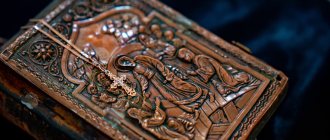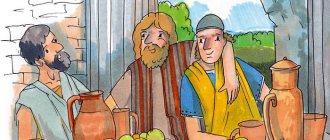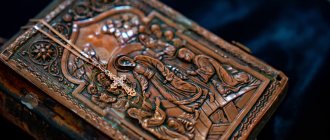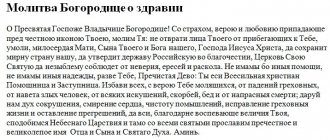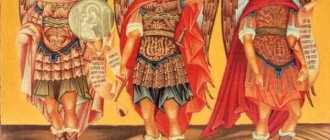Temptation, according to the Bible, is a test that a person must go through in order to earn the love of the Lord. This word comes from the Bible. According to the dogmas set forth in the Holy Scriptures, one should live righteously, turning one's heart away from evil.
Every time we have to choose between good and evil, wealth and meekness, we are exposed to temptation. This is the feeling when there is a desire to crush all the current prohibitions in life.
RECOMMENDED: Who is Jesus Christ.
What does it mean to tempt God?
Each of us is born with a conscience - an “inner voice” that serves as a guide for us, telling us what is good and what is bad. Even as children, we felt when we went against this inner voice.
However, if we deliberately do what we know is wrong and act against our conscience, and at the same time we expect God to bless us and forgive us for the bad things we have done, then we are tempting God.
In the Old Testament, God promised to bless the people of Israel if they kept His commandments, but He also promised to curse them if they did not follow the laws He gave them. (Deuteronomy 30:19.) The Israelites were free to choose blessing or curse, and often they chose to break the laws, turning their hearts away from God. However, despite this, they expected earthly blessings!
It's so easy to have this attitude: I want God to bless me, but at the same time I want to live for myself, do as I want, follow the desires of the flesh. Perhaps I want to be with friends who have a bad influence on me, I'm afraid to object when I know something is bad. Maybe I think it's not so dangerous because “most of the time I'm good” and “God wants me to be a normal person and enjoy life.” Or maybe I even think: “Everything will be fine, I’ll just ask God for forgiveness later.” When I feel this way about everything, then I tempt God because I want Him to bless me, and at the same time I continue to deliberately sin.
This attitude and behavior is actually pride and arrogance for which God will oppose me! How terrible it is - the opposition of God, this is a real curse! However, if I choose to humble myself and renounce my own desires and lusts in order to do His will and not mine, then He will pour out His blessing upon me. This is what is truly a blessing! (James 4:6; 1 Peter 5:5.)
Also: What is true humility?
Chapter 5. The Baptism of Jesus. Temptation
The story of the temptation of Jesus is contained in the first three Gospels, and in the second (Mark) it is presented very briefly; The Evangelist John does not speak about him at all, but not because, as some think, he did not recognize him, but because his Gospel, as we have said more than once, was intended to complement what was missed by the first Evangelists, and should not have repeated what about which enough has already been said.
Jesus was tempted, put to the test. But why was it necessary to test the Sinless One? Could He have sinned?
In answering this question, we should not forget that the sinless Jesus was not only God, but also Man. As a Man endowed with free will, He could be subjected to temptations, and was subjected to them more than once, and if He always turned out to be a winner, it was not because He was endowed with the inability to sin, but because of constant, complete obedience to the Father, because of a boundless aversion from evil.
“The original possibility of not sinning, which contains within itself the possibility of sin, but excludes its reality, developed in Christ into the impossibility of sinning, into an impossibility that cannot sin because it does not want to. If He had been gifted from the very beginning with the inability to sin, He could not have been a true Man, and therefore He Himself could not have been a model for our imitation” (Schaff. Jesus Christ - the miracle of history).
In the first three editions of the Interpretation of the Gospel I found it unnecessary to give more detailed explanations on this subject; but since in the review of my brochure “Worthy Fruits of Repentance” an opinion was expressed about the inconsistency of my discussions about the sinlessness of Jesus Christ contained in that brochure with the teachings of the Orthodox Church, I consider it necessary to place in this fourth edition of “Interpretation of the Gospel” more detailed information on this question of explanation.
The Orthodox Church teaches that Christ is true God and true, but sinless, Man. This is a dogma, the truth of which no Orthodox person can doubt; this is the basis of Orthodoxy.
But why was Christ sinless? Was it because he was born unable to sin, or because he did not want to sin? This is a question that many theologians pass over in silence; meanwhile, it involuntarily suggests itself to everyone who studies the Gospel.
Getting acquainted with the Personality of Jesus Christ as a Man, you involuntarily think that if Christ was born incapable of sin, then He was not born the kind of Man that all people are born, and therefore cannot be, according to His Humanity, an obligatory Model of perfection accessible to us , - this means that we cannot live as Christ the Man lived, we cannot imitate Him. Meanwhile, Christ Himself, pointing to Himself as a Model of not only possible, but also obligatory perfection for us, called to Himself all those who labor in the fight against temptations and are burdened with the severity of sins, He promised them peace of mind if they take upon themselves the yoke of His commandments , and so that this yoke would not seem overwhelming and unbearable to them, He said: “ Learn from Me
(carry it);
carry it as I carry it; be as meek and humble as I am, and then you will see that My yoke is
, and the burden of bearing it is
light
(Matthew 11:428-30).”
Another time, turning to the people and His disciples, He said: deny yourself
(that is, deny your “I”, your will, and live not as you want, but as God commands),
take up your cross, and follow By me
(Matthew 16:24).
That is: imitate Me, live the way I live. In His farewell conversation with the Apostles, Christ gave them an example of humility and service to others and said: I have given you an example, so that you should do the same as I have done to you
(John 13:15).
In a word, Christ commanded us to imitate Him, to fulfill all His commandments as He Himself fulfilled them - to live as He lived according to His Humanity. And the Apostles looked at Him as a Model of the perfection available to us. Thus, the Apostle Peter wrote in his first letter: Christ
left
us an example, so that we should follow in His footsteps
(1 Pet. 2:21).
And the Apostle Paul wrote to the Corinthian Christians: Be imitators of me, as I am of Christ
(1 Cor. 11:1).
In a word, both according to the teaching of the Lord and according to the interpretation of this teaching by the Apostles, we must imitate Christ.
This is how the Holy Fathers of the Church understood this teaching. They taught that God created Adam not for sin, but for a righteous life, but Adam, having abused the free will given to him and subordinating his will to the will of the devil, fell morally and sinned; His descendants followed in his footsteps. Christ, according to His Humanity, restored Adam in His Person as he was before the Fall; Christ proved by His life that free will is given to man not for sin, but for a successful struggle against it, for a righteous life; That is why Christ is called the second Adam.
Touching upon the question of the sinlessness of Jesus Christ, Lactantius said that Christ, by His own example, showed that even in the flesh one can overcome every sin and achieve godlike holiness. And John of Damascus taught that “the Son of God took on our nature (among other things) in order, through Himself and in Himself, to renew the image (of God) and likeness, and (thus) to teach us a virtuous life, through Himself having made it is conveniently accessible to us."
So, according to the teaching of the Fathers of the Church, we are obliged to imitate Christ as a Man and live as He lived. But we could not imitate Him, could not follow in His footsteps, if He had been born incapable of sin, that is, without the free will inherent in us.
Moreover, if Christ had not sinned not because he did not want to sin, but because he could not sin, having been born incapable of it, then why was it necessary to tempt Him? Why did the Holy Spirit lead Him from the Jordan into the desert to be tempted?
from the devil?
Incapable of sinning aimlessly and tempting. If under such circumstances Jesus Christ were tempted by people, then it could be said that they did so out of ignorance. But the temptation for Christ the Man was intended by God Himself, for Christ was led by the Spirit
(Holy)
into the wilderness
(Luke 4:1)
to be tempted by the devil
(Matthew 4:1).
And if Christ the Man could be and was tempted and did not commit a single sin, then we must admit that He did not sin not because He could not, but because He did not want to sin, because He completely subordinated His will to the will of the Father: He did not My will, but Yours be done
(Luke 22:42). And only this recognition makes it obligatory for us to imitate Christ and uncomplainingly march with our cross in His footsteps. The opposite opinion to this attributes to our Lord Jesus Christ the demand from us to fulfill the impossible, the imposition on us of a burden that we are not able to bear, and the very perfection that we are obliged to strive for and which we must achieve, such an opinion turns into an unattainable ideal, therefore, one to which there is no need to strive: if you never reach the goal of the journey you have planned, then why take it? Yes, one can come to such a sad and at the same time extremely erroneous conclusion by asserting that Christ the Man did not sin because he could not sin, because he was born incapable of sinning.
It was said above that our Lord Jesus Christ, according to His Humanity, restored Adam in His Person as he was before the Fall, restored the image and likeness of God in man. Called the second Adam, Christ, of course, was alien to that hereditary inclination to sin, that participation in the original sin of the first man, which is characteristic of us, born from the seed of Adam. But this non-involvement of Jesus in original sin in no way frees us from the obligation to imitate Him, to live as He lived, according to His Humanity. The capacity for sin, inherited by us from our ancestors, is only an inclination towards sin, the possibility of it, but it does not entail sin as a necessary consequence, for even with such participation in original sin there were and are many righteous people.
Jesus Christ not only taught how to create the Kingdom of God on earth, the Kingdom of Love and Goodness, but He Himself fulfilled everything that He taught. Demanding from His followers a constant struggle against the spirit of evil, He Himself, according to His humanity, had to enter into a struggle with it and defeat it, and thereby prove that such a victory is also available to us.
For such and such a struggle, to test His human strength, to prepare Himself for His great work, Jesus the Man went into the desert.
His purpose was, among other things, to create the Kingdom of God on earth and through it to lead people to eternal life in the Kingdom of Heaven. Two paths could lead to this goal. One way is fast, the other is slow. It was possible to quickly spread the new teaching about the Kingdom of God throughout the world, conquering this world and uniting it under the authority of a single King-Messiah; All the Jews of that time dreamed of such and such a Kingdom of the Messiah. The other path, the slow path, consisted in the voluntary moral regeneration of people. Recognizing that the Kingdom of God on earth is possible only among people who are ready to lay down their lives for their neighbors, Christ had to set an example of such selfless love for humanity, which He came to save. In a word, the first path is the path of the quick and brilliant establishment on earth of the Kingdom of God, headed by the triumphant Messiah; the second is a slow and thorny path, associated with suffering not only for the followers of the Messiah, but also for Himself.
While discussing these paths, far from the noise of men, in the wild desert, Jesus was tempted.
Jesus, filled with the Holy Spirit, returned from the Jordan and was led by the Spirit into the desert. There for forty days He was tempted by the devil
(Luke 4: 1–2).
This is what Evangelist Luke says. Evangelist Matthew explains that His Jesus was led up by the Spirit into the wilderness to be tempted by the devil
(Matthew 4:1).
And Evangelist Mark, speaking about a voice from heaven at the Baptism of Jesus, says: Immediately after that the Spirit leads Him into the wilderness
(Mark 1:12). Consequently, Jesus Christ went into the desert directly from the Jordan, immediately after His Baptism.
Speaking about the fact that Jesus was led by the Spirit into the desert, none of the three Evangelists explains by what Spirit; therefore, some interpreters believed that Jesus was drawn into the desert by the Spirit of evil, the same one who later tempted him. But this interpretation clearly contradicts the literal meaning of the gospel accounts of this event. Evangelist Luke says that Jesus, filled with the Holy Spirit
, returned from the Jordan and was led by the Spirit into the desert, of course, by the same Spirit with which he was filled, that is,
the Holy One.
Evangelist Matthew says that Jesus was led up by
the Spirit
into the wilderness, to be tempted by the devil, contrasting here
the Spirit,
who leads Jesus into the wilderness,
with the devil,
from whom Jesus will be tempted. Evangelist Matthew leaves no doubt that, speaking about the Spirit, he talks about the Holy Spirit.
Moreover, in the stories about the temptation of Jesus, the Evangelists never once called the devil a spirit
(of evil), but called him the devil, the tempter, Satan.
The Gospels do not say exactly what desert the Holy Spirit led Jesus into; Tradition says that the place of temptation was the desert located between Jericho and Jerusalem; one of the mountains of this desert is called the Forty Days,
according to the forty-day fast of Jesus Christ on it.
There for forty days He was tempted by the devil
(Luke 4:2).
Evangelist Matthew says that the tempter came to Christ after forty days,
when Christ felt hungry, and the Evangelist Luke says that the devil tempted Christ
during all forty days
of His stay and fasting in the desert.
There is no contradiction here; There is no doubt that Jesus Christ was subjected not only to those temptations in the desert, which the Evangelists Matthew and Luke narrate in such detail, but also to others. The Evangelist Luke himself, finishing his story about the temptation in the desert, says: the devil departed from Him for a time
(Luke 4:13), that is, he did not leave Him forever, but only for a while.
And indeed, temptations were repeated throughout the public ministry of Jesus Christ, and if not directly from the devil, then through him from other persons: tempting Him, the Apostle Peter persuaded Him to remove from Himself the impending death on the Cross; the Pharisees tempted Him, demanding a sign from heaven; they tempted Him on the Cross with the words of the devil himself - if you are the Son of God, come down from the cross
(Matthew 27:40); They were tempted, of course, in other cases, which the Evangelists kept silent about, since they did not set out to create a complete description of the life of Jesus Christ. Therefore, the story of the Evangelist Luke that Jesus was subjected to temptations throughout the forty days of fasting is completely reliable; but since he does not say what these preliminary temptations were, the silence about them on the part of the Evangelist Matthew does not in the least shake the reliability of his narrative.
Evangelist Mark, for all the brevity of his story about temptation, reports that Jesus was with the beasts
(Mark 1:15).
This remark cannot be explained by the Evangelist’s desire only to strengthen the idea of \u200b\u200bthe savagery of the desert where Christ fasted; it certainly has a special meaning. We know that Jesus Christ, having heard from the seventy disciples who returned from preaching that the demons obeyed them, said: I give you power to tread on snakes and scorpions and over all the power of the enemy, and nothing will harm you
(Luke 10:19);
sending the Apostles to go throughout the world to preach the Gospel, He said that His followers would take up snakes
, and the snakes would not harm them (Mark 16:18). If, therefore, the true followers of Christ must rule over the beasts, if with their spirit, holiness, they must subjugate the beasts to their will, then, of course, Jesus Christ acted on the beasts of the desert with the same power of His sinlessness and holiness, which He imparted to His followers .
It seems simply incomprehensible to us how it is possible to be among wild animals and remain unharmed. But why are animals so dangerous to us? Why are they so hostile towards us? Is it because man was the first to attack and kill them? Is it because people themselves instilled in them fear and self-hatred, and that these feelings, passing to subsequent generations successively, through hereditary transmission, developed in them an irreconcilable hostility towards us? But was it like that in the beginning? Were not the first people as safe among wild beasts as Christ was in the desert?
Christ did not eat anything during these days, and after they were over, he finally became hungry
(Luke 4:2).
Jesus felt hungry only after forty days of complete abstinence from food. Why did He not experience the pangs of hunger during these forty days? This cannot be explained by the divine power of Christ, since He never used this power personally for Himself; He did not feel hunger for so long, because, after the completion of Baptism, the descent of the Holy Spirit and the favor witnessed by the Father to the beginning of His redemptive work, He was completely immersed in this work, in fulfilling the will of Him who Sent Him, and at such a time of the unconditional dominion of the Spirit over not noticing the infirmities of the body, did not feel hunger; and when he felt the pangs of hunger, the tempter approached Him
(Matthew 4:3).
Make the right choice.
In John 8:12, Jesus says, “Whoever follows Me will not walk in darkness, but will have the light of life.” If I act contrary to what I know is right, then I am willingly walking in darkness and God cannot bless me. Then I will be cursed. If I truly love Jesus and want to please Him in everything I do, then I walk in the light like Him. This means that when I am faced with a choice, I choose what is good and right because I do not want to disappoint Him. This leads to me losing my life, renouncing my will, my desires, my thoughts, etc. - for him. However, by doing this, I gain peace in my heart, because even if no one else sees my sacrifice, I am doing what is pleasing to Him and God will bless me. (Matt. 10:39.)
It is written about Jesus that He “loved righteousness and hated iniquity,” and this has always been the case. (Heb. 1:9.) His eyes scan the whole earth, He seeks those who seek righteousness where no one sees them, out of love for Him. (2 Chronicles 16:9.)
The last temptation of Christ in the desert - the temptation of faith
Seeing that he was unable to tempt Christ, the Devil prepared a third and final test for him. He showed Him all the kingdoms of the world over which He had authority, and said:
(Luke 4:6-7)
“I will give you power over all these kingdoms and their glory, for it has been given to me, and I give it to whomever I want; So, if You worship me, then everything will be Yours"
Then Jesus answered:
“Get behind Me, Satan; It is written: “Worship the Lord your God, and serve Him only.”
“The Temptation of Christ on the Mountain” (fragment of Duccio’s “Maesta”, 1308-1311).
The last temptation of Christ consisted in the Devil offering Christ power over all the kingdoms subject to him. Here the Devil decided to confuse the human spirit of Christ and sow doubts about the possibility of Christ carrying out the work of saving mankind. The Savior rejects this temptation, which shows that he does not recognize the power of Satan over the world, which belongs to God, to whom worship is due.
Thus, Jesus Christ, tempted by Satan, successfully resists all his attempts to prevent Him from fulfilling His Divine mission.
“Go and sin no more.”
While in the wilderness, Jesus turned to the Word of God to defeat Satan. And He made this possible for us during our life on earth: “Go and sin no more.” John 8:11.
When my thoughts are aimed at pleasing God in everything, He sends me the Holy Spirit, who will willingly strengthen me so that I can overcome all sin! Just as much as God hates sin, He loves us and wants us to experience His blessing over our lives. He promised that when we sacrifice everything for Him, He will shower His blessing on us in such a way that there is not enough room to contain it! (Malachi 3:10.) This is a blessing that is not only about earthly things, but even more about victory over sin and freedom from sin, and the promise is that we will become partakers of the greatest and most precious promises God has given us! (2 Peter 1:2-4.)
More about the promises that God has given us: 25 quotes from the Bible that bring us great joy.
The Bible is full of promises for those who keep God's commandments, but it is also full of consequences for those who choose not to do what is right. When God gave the commandments to the people of Israel, He left the choice up to them, and He also gives us the choice now. “I have set before you life and death, blessing and curse. Choose life …” Deut. 30:19. Let us awaken so that we can see these opportunities that God is sending us and humble ourselves before Him so that His blessing may rest upon our lives!
The Devil prepared three temptations for Christ in the desert
The Christian Church believes that the temptation of Christ in the desert after a forty-day fast was directed against the human nature of Jesus, influencing which the Devil hoped to seduce Christ onto the wrong path.
Thus, the “new Adam”, who incarnated in order to save humanity, during his stay in the desert fought with the Devil, who longed to maintain power over people. For this purpose, the Enemy of the human race prepared three temptations for Jesus.
"Christ led by the Spirit into the wilderness." William Hall, 1908 Christ, led by the Spirit into the desert, went there, among other things, to point out the trinity of Divine persons
These three temptations affect almost all sinful areas. In the Holy Scriptures they are called as follows:
- temptation of hunger;
- temptation of pride;
- temptation by faith.
Jesus Christ went into the desert to fast after his baptism.
Many believers ask: why was Christ sent by the Spirit into the desert? The Son of God could well have avoided all temptations. The Monk Ephraim the Syrian responds to this in his writings as follows:
“... so that none of the unbelievers have an excuse to say that the Spirit is later and lower than the Son.”
Thus, Christ’s stay in fasting and prayer in the desert after baptism is, among other things, evidence of the trinity of Divine persons who all participate in this.
Job North Russian icon, 17th century. There is a parallel with the temptation of Christ in the wilderness and the trials of Job
There are parallels in the Bible with the temptation of Christ in the wilderness with the trials of Job. The Prophet was also subjected to three tests and in the last test Satan also offered to worship him.
In addition, analogies are seen with the Exodus of the Jews from Egypt, for example, the Jews crossed the Jordan, and Jesus Christ was baptized in it, the Savior fasted for forty days and the Israelites experienced hunger in the desert.
The Temptation of Christ is not a very common subject in art
In fine art, the temptation of Christ is not recognized as a common plot. Most often it is present in pictorial depictions of the entire cycle of events in the life of Christ as one of its episodes.
All three temptations are depicted, as well as simply Christ standing next to the Devil on the top of the mountain. In the first case, the first temptation is presented in large detail in the foreground, and the second two are placed in the background.
“Temptation of Christ” (stamp of the icon of the Almighty Savior, 1682). In Orthodox iconography, the plot of the temptation of Christ in the desert is usually depicted on icons of the Baptism of the Lord
Orthodox painting is characterized by the placement of a scene of the temptation of Christ on the icons of the Baptism of the Lord. Typically, a painting with the plot of the temptation of Christ has three compositions according to the number of temptations:
- “Jesus in the Desert”: Temptation by Hunger.
- “Jesus on the wing of the temple”: The temptation of pride.
- “The Temptation of Christ on the Mountain”: Temptation by Faith.
In addition to the image of Christ in the paintings dedicated to his temptation, images of the Devil are also interesting. Thus, in Romanesque and Gothic art, as well as during the Early Renaissance, Satan was usually depicted as the spirit of darkness.
Such images are characterized by the image of a demon with horns, a scaly body, wings and claws on his hands and feet. During the High Renaissance, Italian artists painted him as a “fallen angel”, in the image of a comely youth.
Paintings with the plot of the temptation of Christ in the desert have 3 compositions - according to the number of temptations.
Since this plot concerns the image of the Lord, the Christian Church has always closely followed the work of representatives of art affecting it. For example, Martin Scorsese’s film “The Last Temptation of Christ” was subjected to severe criticism from Christian circles. In some countries around the world it was even banned from being shown.
By leaving a comment, you accept the user agreement
Harmony with the will of God the Father
Moreover, the will of Christ as a man was always in complete harmony with the will of his Father, therefore no conflict or contradiction existed between them. Maximus the Confessor introduced such concepts as physical will and gnomic will. Physical is associated with human nature, and gnomic is associated with personality traits and represents the “will of choice” (derived from the Greek word γνωμη, meaning intention, choice).
In man, tossing between good and evil occurs at the level of gnomic will. While they were unknown to Christ, he possessed a physical will, but was free from the torment of choice, since his will was deified and could not be inclined to evil. Thus, Jesus had the opportunity to commit sin as a man, but rejected sin because He possessed divine perfection.
Elizabeth Taylor was married eight times. The reason was her parents
Study: Drinking coffee half an hour before exercise speeds up fat burning
More comfortable in crowds: Emotional safety and anxiety from close friendships.

